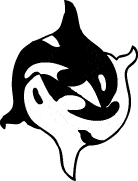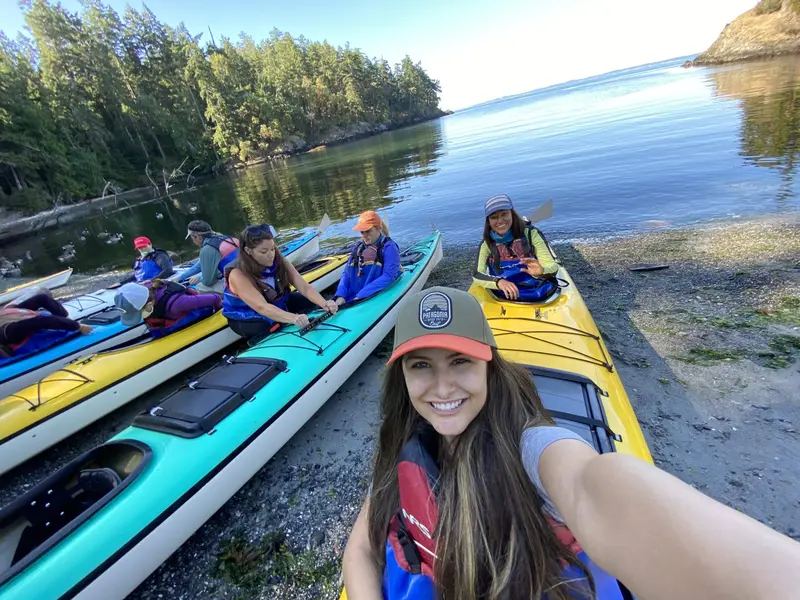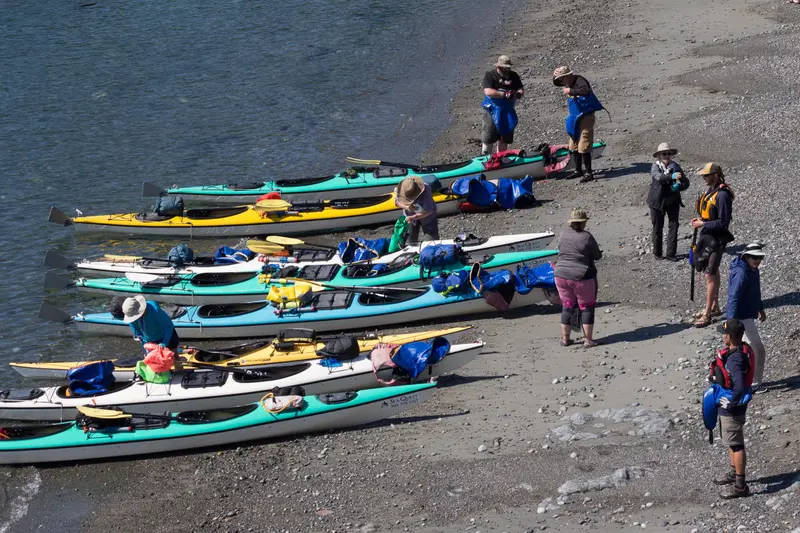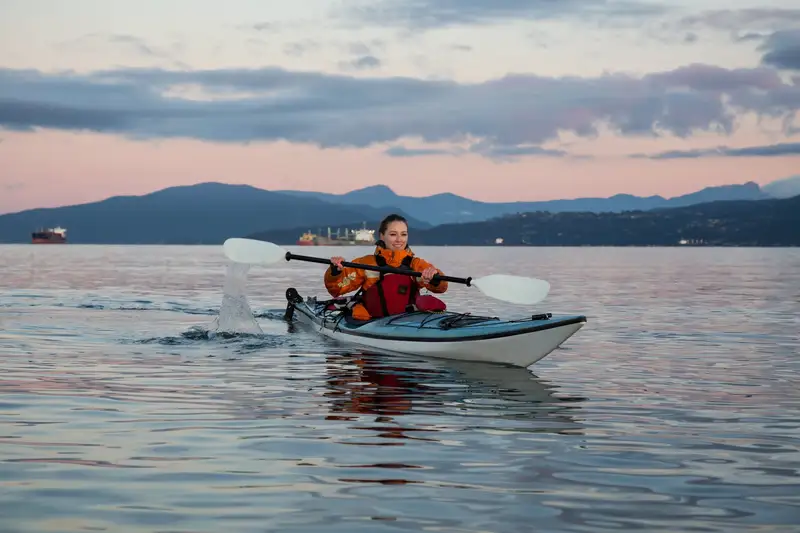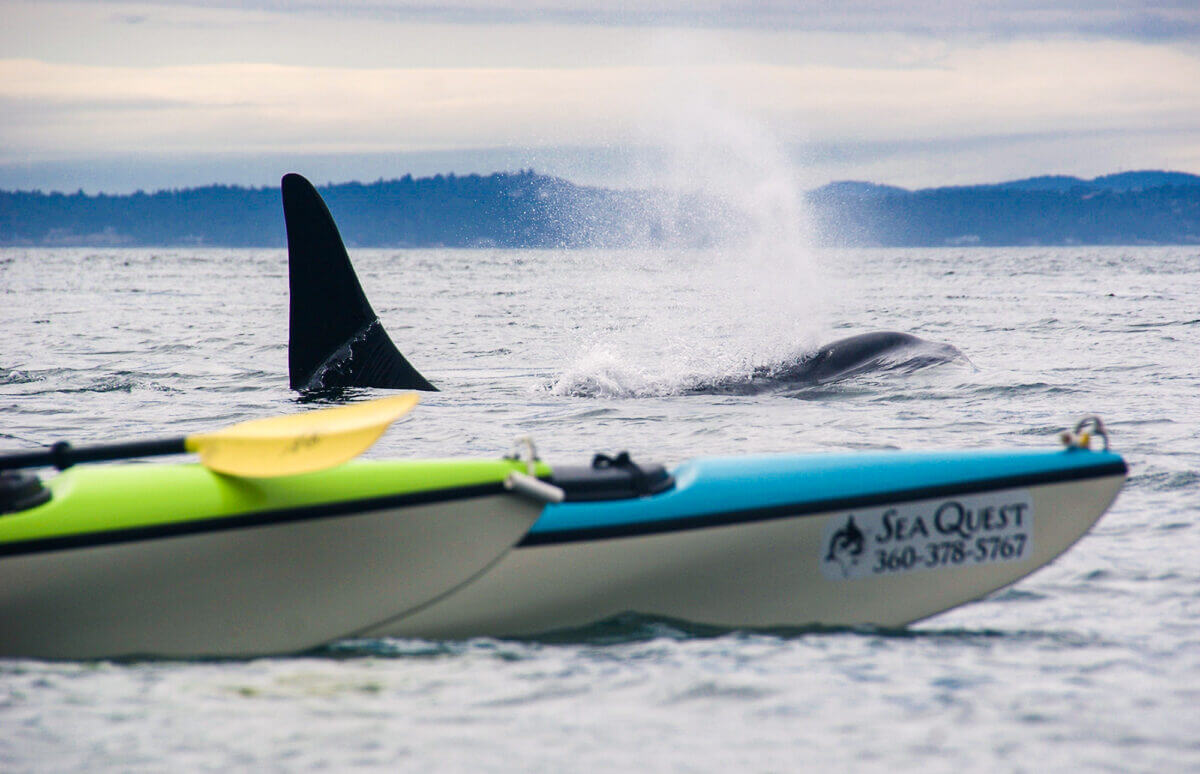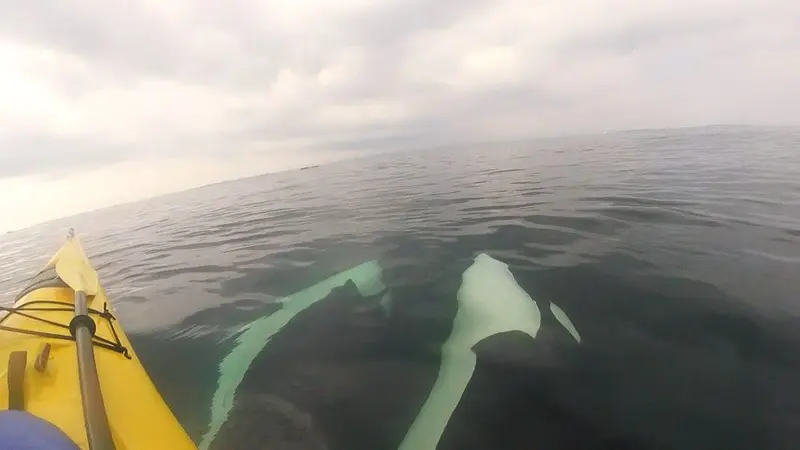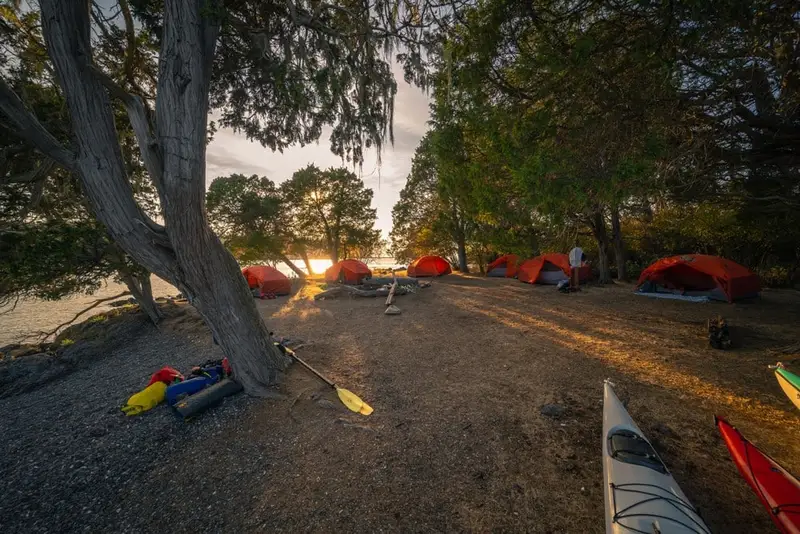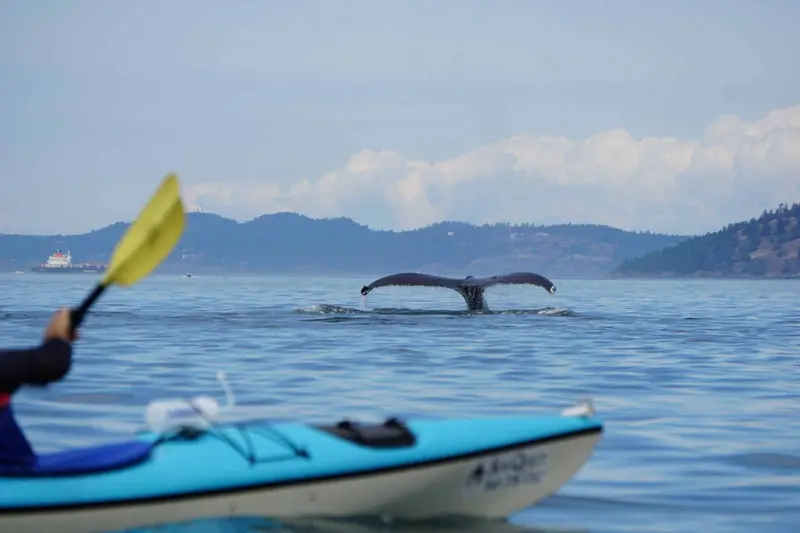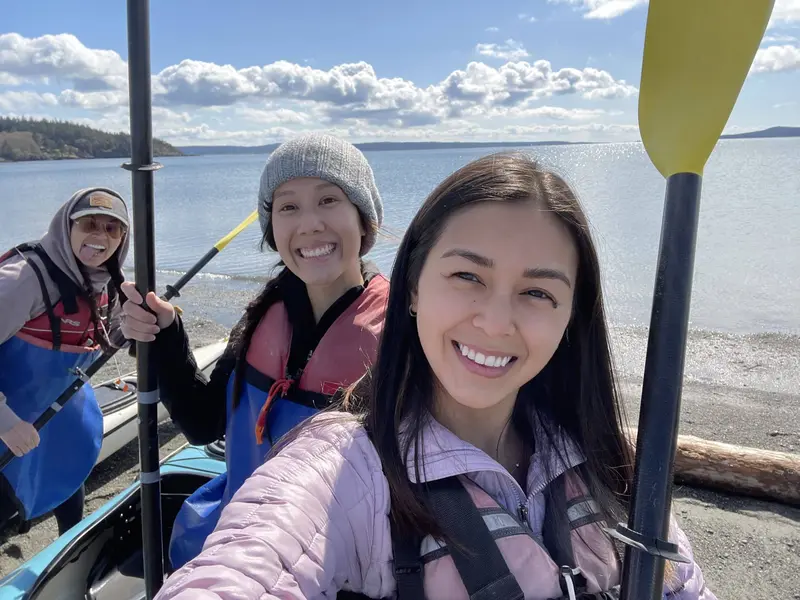Sea Kayaking Dictionary, Glossary, & Terminology
What to Know
Menu
Sea kayaking, like other marine activities, uses a unique assemblage of phrases and words. Understanding some of the important paddling words can be a quite useful when participating on a kayak trip. Here is our sea kayaking dictionary from A to Z to keep your paddling education moving along. Naturally, you don’t need to memorize all of the words in our kayak dictionary. But they are fun to learn, can enhance your enjoyment of sea kayak trip, and maybe help you win jeopardy! At the very least you can entertain your friends with your maritime acumen.
Sea Kayaking Dictionary from A to Z
- Aft – Toward the rear, or stern, of a kayak.
- Astern – Toward the rear of a kayak.
- Backpaddle – Using a reverse stroke to paddle backward or slow the forward motion of a kayak.
- Ballast – Weight in the kayak such as paddlers and gear increases kayak stability.
- Beam – The width of a kayak as measured at its widest point.
- Bilge – The low point on the inside of a kayak’s hull where water can puddle.
- Bilge pump – A pump used to remove water that collects in the bilge.
- Bow – The front or forward end of the kayak.
- Brace – A stroke used to provide support and keep the kayak stable. See “high brace” and “low brace.”
- Broach – To get pushed off course so that the kayak is unfavorably oriented broadside to waves, currents, or an obstacle. An uncontrolled broach can lead to a capsize.
- Bulkhead – A partition inside the kayak that creates a separate watertight compartment for gear stowage and safety buoyancy.
- Capsize – The act of flipping or rolling a kayak into an inverted position.
- Channel – A section of passable water between islands, reefs, shoals, and other obstructions. See “strait”
- Chart – A map for marine navigation.
- Cleat – A fitting used for tying lines to. Often attached to the deck of a kayak, they have two protruding horns. We also use them to park our paddles in place when resting.
- Cockpit – The opening in the kayak deck in which the paddler sits.
- Coaming – The rim of a kayak cockpit to which a spray skirt is attached.
- Course – Intended direction for a vessel to travel.
- Dead reckoning – A navigational method popular in sea kayaking. Determining position by taking into account such factors as currents, wind speed, and your projected course and speed.
- Deck – The upper surface or top of a kayak.
- Draft – The distance between the waterline on a kayak and the bottom of the boat’s keel. Kayaks have a very shallow draft.
- Draw stroke – A paddle stroke used to move the kayak sideways.
- Dry bag – A waterproof bag kayakers use to protect the items they bring with them.
- Ebb – An outgoing current created by a falling tide. See “flood” and “slack”.
- Eddy – A deflection of the main current caused by an obstruction in the flow such as an island or reef. Eddies often flow in reverse of the main current (a back eddy) and so kayakers who are traveling against the current often seek eddies out to conserve energy.
- Eddy line – Typically a visible boundary that separates the opposing currents in an eddy.
- Feather – Paddle blades oriented at different angles to minimize drag created by head winds.
- Ferry – To move a kayak across a moving body of water by angling the bow into the current so as to minimize drifting down current.
- Fiberglass – A lightweight composite material used in the construction of the most expensive kayak hulls such as those used at Sea Quest. Fiberglass is lightweight, strong and creates minimal drag.
- Flatwater – Calm river, lake, or ocean water without rapids or high waves.
- Flood – An incoming current created by a rising tide. See “ebb” and “slack”.
- Flotation – Buoyancy inside the hull to keep the kayak from sinking in the event of capsize.
- Following sea – Waves that overtake a kayak from from astern. See “seas”.
- Foot brace – A pedal-like foot rest that provides leverage for an efficient paddle stroke, improves stability in rough seas, and in some cases controls the rudder for steering.
- Gunnel or Gunwale — The rails or side edges of a kayak, often marked by a seamline on fiberglass kayaks.
- Hatch — A waterproof hold inside the kayak where you can store items you’re taking with you. The removable cover on top is called a hatch cover.
- Heading — The direction in which a kayak is pointing at a given moment.
- High brace — A strong, supportive stroke used when storm waves or surf threatens to capsize a kayak.
- Low brace — A supportive stroke used to maintain stability in less extreme kayaking conditions.
- Hull — The bottom shell of a kayak or other boat.
- Hypothermia — A condition where the body’s core temperature drops to a dangerous level, normally in wet and cold conditions. See our page on hypothermia and kayaking.
- Kayak — Similar to a canoe but equipped with a deck for greater seaworthiness. A lower center of gravity from the seat positions greatly increases stability compared to canoes.
- Keel — The centerline ridge that runs along the hull of the kayak from bow to stern that helps maintain a straight course and provides stability.
- Knot — A nautical mile-per-hour measure of speed equal to 1.15 statute miles per hour. See “nautical mile”. is 6076 ft . A stature mile is 5280 ft.
- Launch — The act of transitioning the kayak from shore into the water.
- Lee — A calm area behind an object that blocks the wind.
- Leeward — The downwind side of the kayak. The opposite of “windward”.
- Life jacket — Now known as a PFD (personal floatation device) and worn in a kayak to provide buoyancy in emergencies.
- Line — This is what landlubbers call a rope; the Rudder Line is used to raise or lower the kayak rudder.
- Nautical mile — Unit of distance equal to 6076.1 ft. Original intended to be one minute of latitude (1/24,000 of the circumference of the earth at the equator).
- Outfitter — A company that supplies kayaking equipment.
- Paddle — The device used to propel a kayak through the water.
- Paddle blade — The wide, flat end of a paddle; the only part of the paddle that is inserted into the water.
- Paddle face — The power face; the side of a paddle blade that pushes against the water.
- Paddle shaft — The section of the paddle that is gripped between the blades.
- PFD — Personal Flotation Device. See “life jacket”.
- Pivot — A sharp turn executed while remaining in one place on the water.
- Port — The left side of the kayak when facing the bow. Opposite of “starboard”.
- Power face — The face of a paddle blade that pushes against the water.
- Quartering — To move at an angle to the wind or waves. This helps to maintain speed and minimizes the chances of the bow or stern getting pushed below the surface in rough water.
- Rip — A fast, turbulent stretch of water caused by conflicting currents and/or winds. See “weather rip” and “tide rip”.
- Read the water — To look for visual cues that reveal current nuances, eddies, and other factors that increase efficiency and/or decrease risks while kayaking.
- Reef — A shallow area created by a submerged ridge of rocks or coral.
- Rudder — The vertical fin mounted on the stern of the kayak that is used to steer the boat.
- Sculling – A supportive stroke characterized by a side to side movement of the paddle using quick changes of power face angles. Can also be used as a “draw stroke” technique.
- Seam – The inch-wide line along the gunnels of a fiberglass kayak where the deck and hull are joined together.
- Seas – Steep or choppy waves that are created nearby from wind and dissipate quickly when the wind abates. Also called wind waves.
- Skeg – A small fin mounted on the stern keel that provides increased tracking in windy conditions on rudderless kayaks.
- Shoal – A shallow area in a body of water, often formed by a sandbar or reef.
- Slack water – A brief period of stillness (or slower currents) that occurs when at the transition from ebb to flood or back again. See “ebb” and “flood”.
- Solo kayak – A one-person kayak, also known as a single kayak.
- Spray skirt – The garment worn around the paddler’s waist that attaches to the cockpit coaming to keep water from entering the kayak.
- Stability – A measure of how difficult it is to capsize. The kayaks used by Sea Quest are designed to be very stable.
- Standing wave – A wave that remains stationary, often found in “tide rips”.
- Starboard – The right side of the kayak when facing the bow. Opposite of “port”.
- Stern – The rear of the kayak or other watercraft.
- Strait – A broad expanse of water that separates two large land masses. See “channel”.
- Stroke – A variety of paddling movements used to control the speed and direction of a kayak.
- Surfing – Riding a steep wave front; to be avoided by beginner kayakers.
- Swamp – When a kayak is inadvertently filled with water by passing waves.
- Swells – Large rounded waves formed in the ocean by the consolidation of many smaller wind waves (which are called “seas”). Swells can travel across the world and create surf on shore.
- Tandem kayak – A two-person kayak, also know as a double kayak.
- Tide rip – Something of a misnomer that should be called a “current rip” as they have nothing to with tides! A so-called tide rip can form when strong currents collide or otherwise conflict to create patches of rough, choppy water. Severe rips can develop whirlpools and other interesting features and are often used as play areas by experienced sea kayakers.
- Triple kayak – A three-person kayak, often used by families with children. Adventure racing teams prefer them as they are the fastest of all sea kayaks.
- Vhf radio – Very High Frequency radiotelephone; used for two-way communication between vessels and to obtain current weather conditions and forecasts.
- Waterline – The line of water along the hull of a kayak or other water craft when it is afloat.
- Wave crest – The summit of a wave, opposite of the trough.
- Wave trough – The depression between two wave crests.
- Weather rIP – A rough area of water caused by winds and currents flowing in the opposite direction of each other which increases the surface friction and raises waves.
- Wet exit – Exiting a capsized kayak when rolling is not an option.
- Windward – The direction from which the wind blows. The opposite of “leeward”.

